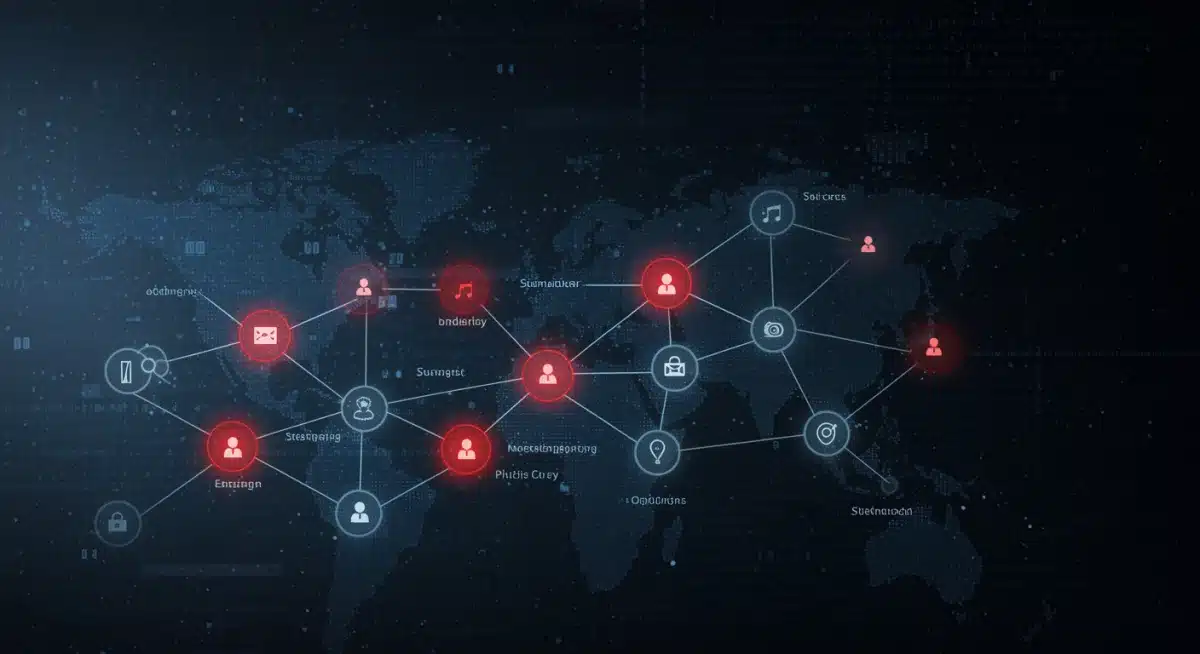Cybersecurity Threats 2025: Emerging Vulnerabilities in Connected Devices for US Consumers

Cybersecurity Threats in 2025: A Look at 3 Emerging Vulnerabilities in Connected Devices for US Consumers are rapidly evolving, with AI-powered attacks, supply chain compromises, and unpatched legacy systems presenting critical risks to digital safety.
As we move into 2025, the landscape of digital security for American consumers is shifting dramatically. The increasing reliance on smart devices and interconnected technologies brings unprecedented convenience but also exposes users to new and sophisticated risks. Understanding these evolving Cybersecurity Threats in 2025: A Look at 3 Emerging Vulnerabilities in Connected Devices for US Consumers is no longer optional; it’s essential for safeguarding personal data and maintaining digital integrity.
The Rise of AI-Powered Cyber Attacks on Smart Devices
Artificial intelligence, while a boon for innovation, is increasingly being weaponized by malicious actors. In 2025, AI-powered cyber attacks are no longer theoretical; they are a present and growing danger, capable of bypassing traditional security measures on connected devices.
These sophisticated attacks leverage machine learning to adapt, learn, and execute complex intrusions with an efficiency previously unattainable. For US consumers, this means smart home devices, wearables, and even connected vehicles are facing a new generation of threats that are harder to detect and defend against.
Sophisticated Phishing and Social Engineering
AI’s ability to generate highly convincing text and voice content makes phishing and social engineering attacks significantly more potent. Attackers can craft personalized, contextually relevant messages that are nearly indistinguishable from legitimate communications.
- AI-generated deepfakes for voice and video can trick individuals into divulging sensitive information.
- Automated bots can engage in extended conversations, building trust before exploiting vulnerabilities.
- Personalized spear-phishing campaigns are now scalable, targeting thousands of users simultaneously.
Autonomous Malware and Evasion Techniques
AI-driven malware can learn from its environment, adapting its behavior to evade detection by conventional antivirus software. This new breed of threats can independently identify and exploit weaknesses in connected device ecosystems.
These autonomous threats can lie dormant, observing network traffic and user behavior to choose the optimal time and method for attack, making them exceptionally difficult to quarantine once inside a network. Their self-modifying capabilities ensure they remain a step ahead of signature-based detection systems.
Supply Chain Vulnerabilities in IoT Ecosystems
The interconnected nature of modern technology means that a vulnerability at any point in the supply chain can compromise the security of the end-user device. In 2025, supply chain attacks are a critical concern, directly impacting the integrity of connected devices used by US consumers.
These attacks often target software components, hardware manufacturing, or even the logistics of device distribution, introducing malicious code or compromised hardware long before a product reaches the consumer. The widespread ripple effect of such breaches makes them particularly dangerous.

Pre-Infection at Manufacturing Stages
Attackers are increasingly targeting the manufacturing phase of IoT devices, embedding malware or backdoors directly into hardware or firmware. This ‘pre-infection’ means devices are compromised before they are even purchased.
- Malicious code can be injected into the firmware during production, creating persistent vulnerabilities.
- Counterfeit components with hidden exploits can be integrated into legitimate devices.
- Lack of stringent security audits at every stage of manufacturing leaves doors open for compromise.
Software Component Exploitation
Many connected devices rely on third-party software libraries and open-source components. Exploiting a vulnerability in one of these widely used components can grant attackers access to a vast number of devices.
This method allows for a ‘one-to-many’ attack, where compromising a single software dependency can affect millions of devices across different manufacturers and product lines. Keeping track of and securing every component in a complex software stack is a monumental challenge.
Legacy Systems and Unpatched Devices as Entry Points
Despite rapid technological advancements, a significant number of older, less secure connected devices remain in use within US households and infrastructure. These legacy systems, often unpatched and unsupported, represent critical vulnerabilities for 2025 cybersecurity.
These devices, ranging from early smart home hubs to outdated network routers, were not designed with modern cybersecurity threats in mind. Their continued operation creates easily exploitable entry points for attackers seeking access to broader home networks and sensitive data.
Lack of Vendor Support and Updates
Many manufacturers cease providing security updates for older devices after a few years, leaving them permanently exposed to newly discovered vulnerabilities. Consumers often continue using these devices due to cost or convenience.
- Outdated firmware contains known exploits that are trivial for attackers to leverage.
- Unsupported devices cannot receive critical security patches, making them ‘sitting ducks.’
- Consumers are often unaware when a device reaches its end-of-life for security support.
Integration with Newer, Secure Systems
The integration of insecure legacy devices with newer, more secure systems can create a weak link, undermining the overall security posture of an entire network. A single vulnerable device can compromise the security of an otherwise robust smart home setup.
This creates a paradoxical situation where efforts to upgrade security in one area can be nullified by the presence of an unpatched device elsewhere on the network. Attackers actively seek out these weakest links to gain initial access.
Data Privacy Risks from Emerging Cyber Threats
Beyond direct device compromise, the Cybersecurity Threats in 2025: A Look at 3 Emerging Vulnerabilities in Connected Devices for US Consumers significantly amplify data privacy risks. Personal information collected by connected devices, from health metrics to consumption habits, becomes a prime target for exploitation.
The sheer volume and intimacy of data collected by IoT devices mean that breaches can have far-reaching consequences, extending beyond financial fraud to identity theft, blackmail, and even physical security risks if location data or smart home controls are compromised.
Exploitation of Personal Biometrics
Many connected devices now utilize biometric data for authentication, such as fingerprints or facial recognition. A compromise of these systems could lead to irreversible identity theft, as biometric data cannot be reset like a password.
- Biometric data stored on vulnerable devices could be exfiltrated and used for fraudulent purposes.
- Deepfake technology can be used to bypass biometric authentication systems if sufficient data is obtained.
- The permanent nature of biometric identifiers makes their compromise a particularly severe privacy breach.
Behavioral Data and Profiling
Connected devices continuously collect behavioral data, offering insights into daily routines, preferences, and habits. This data, if breached, can be used for targeted scams, social engineering, or even sold on dark web markets for various nefarious purposes.
The aggregation of data from multiple devices paints a detailed picture of an individual’s life, making them vulnerable to highly personalized attacks or exploitation by advertisers and other entities without explicit consent or knowledge.
Mitigation Strategies for US Consumers
Addressing these emerging cybersecurity threats requires a proactive and multi-layered approach from US consumers. While the threats are complex, several practical steps can significantly enhance the security of connected devices.
Staying informed about potential vulnerabilities and regularly updating device security practices are paramount. The responsibility for digital safety increasingly falls on the end-user, making consumer education a vital component of national cybersecurity.
Regular Software and Firmware Updates
Consistently applying software and firmware updates is the single most effective way to protect connected devices. These updates often contain critical security patches that address newly discovered vulnerabilities.
- Enable automatic updates whenever possible on smart devices and routers.
- Manually check for updates for devices that do not offer automatic patching.
- Prioritize updates for devices that handle sensitive data or control physical access.
Strong, Unique Passwords and Multi-Factor Authentication
Using strong, unique passwords for every connected device and account, combined with multi-factor authentication (MFA), creates a robust barrier against unauthorized access, even if one password is compromised.
MFA adds an extra layer of security, requiring a second form of verification beyond just a password. This significantly reduces the risk of account takeover, especially for critical services linked to smart devices.
The Role of Government and Industry in Consumer Protection
While individual actions are crucial, the broader fight against Cybersecurity Threats in 2025: A Look at 3 Emerging Vulnerabilities in Connected Devices for US Consumers also requires significant contributions from government and industry. Regulatory frameworks and security standards play a vital role in shaping a safer digital environment.
Cooperation between device manufacturers, software developers, and government agencies is essential to establish baseline security requirements, promote responsible data handling, and provide support for consumers navigating an increasingly complex threat landscape.
Establishing IoT Security Standards
Governments and industry bodies are working to establish mandatory security standards for IoT devices, ensuring that products meet a minimum level of security before reaching the market. This aims to eliminate inherently insecure devices.
- Regulations requiring ‘security by design’ principles in IoT product development.
- Mandates for clear security update policies and end-of-life support for devices.
- Certification programs to help consumers identify secure and trustworthy products.
Public Awareness Campaigns and Education
Government initiatives can fund and promote public awareness campaigns to educate consumers about common cybersecurity threats and best practices for securing their connected devices. This empowers users to make informed security decisions.
These campaigns can demystify complex cybersecurity concepts, providing actionable advice in an accessible format. Educated consumers are the first line of defense against many types of cyber attacks, reducing their susceptibility to social engineering and other exploits.
| Key Threat | Brief Description |
|---|---|
| AI-Powered Attacks | Malicious AI adapts to bypass security, enabling sophisticated phishing and autonomous malware. |
| Supply Chain Vulnerabilities | Compromises injected at manufacturing or via third-party software before devices reach consumers. |
| Legacy & Unpatched Devices | Older devices lacking security updates create easy entry points for attackers to exploit. |
| Data Privacy Risks | Exploitation of sensitive personal and behavioral data collected by connected devices. |
Frequently Asked Questions About 2025 Cybersecurity
The main threats include AI-powered attacks like sophisticated phishing and autonomous malware, vulnerabilities within the supply chain compromising device integrity, and the continued use of unpatched legacy devices that offer easy entry points for cybercriminals.
AI-powered attacks are more adaptive and autonomous. They can learn from their environment, generate highly convincing content for social engineering, and evolve to evade detection, making them significantly harder to combat than static, rule-based attacks.
Supply chain vulnerabilities mean devices can be compromised at any stage, from manufacturing to distribution. Malicious code or hardware can be embedded before the product reaches the consumer, leading to widespread, difficult-to-detect infections.
Legacy devices often lack security updates, leaving them susceptible to known exploits. They act as weak links, allowing attackers to breach an entire home network, even if newer devices are secure, compromising data and privacy.
Consumers should regularly update software, use strong unique passwords, enable multi-factor authentication, and be vigilant about phishing attempts. Disconnecting unsupported legacy devices or isolating them on a separate network can also mitigate risks.
What Happens Next
The escalating nature of Cybersecurity Threats in 2025: A Look at 3 Emerging Vulnerabilities in Connected Devices for US Consumers demands immediate and sustained attention. We anticipate increased regulatory action from governments to mandate stronger security-by-design principles for IoT manufacturers. Furthermore, a concerted effort will be required to develop AI-driven defense mechanisms that can counter the evolving sophistication of AI-powered attacks. Consumers must stay informed and proactive, as the digital battleground expands into every connected aspect of daily life, making digital literacy a cornerstone of modern safety.





